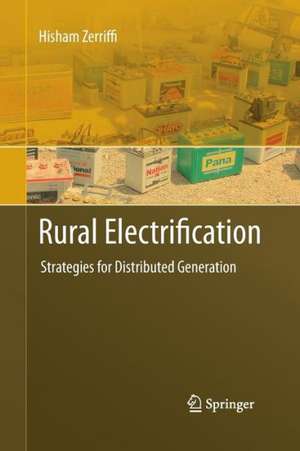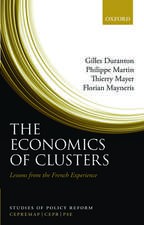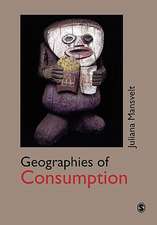Rural Electrification: Strategies for Distributed Generation
Autor Hisham Zerriffien Limba Engleză Paperback – 15 oct 2014
Small-scale Distributed Generation (DG), ranging from individual solar home systems to village level grids run off diesel generators, could provide the answer, and this book compares around 20 DG enterprises and projects in Brazil, Cambodia and China, each of which is considered to be a "business model" for distributed rural electrification. While large, centralized power projects often rely on big subsidies, this study shows that privately run and localized solutions can be both self-sustaining and replicable. Its three sections provide a general introduction to the issue of electrification and rural development, set out the details of the case studies and compare the models involved, and discuss the important thematic issues of equity, access to capital and cost-recovery.
Hisham Zerriffi shows that in each case, it is not simply a matter of matching a particular technology to a particular need. Numerous institutional factors come into play including the regulatory regime, access to financial services, and government/utility support or opposition to the DG alternative. Despite this, in many countries, the question is not whether DG has a role to play. Rather it is a question of how it will play a role.
| Toate formatele și edițiile | Preț | Express |
|---|---|---|
| Paperback (1) | 940.72 lei 6-8 săpt. | |
| SPRINGER NETHERLANDS – 15 oct 2014 | 940.72 lei 6-8 săpt. | |
| Hardback (1) | 945.79 lei 6-8 săpt. | |
| SPRINGER NETHERLANDS – 7 noi 2010 | 945.79 lei 6-8 săpt. |
Preț: 940.72 lei
Preț vechi: 1147.21 lei
-18% Nou
Puncte Express: 1411
Preț estimativ în valută:
180.03€ • 185.98$ • 149.83£
180.03€ • 185.98$ • 149.83£
Carte tipărită la comandă
Livrare economică 25 martie-08 aprilie
Preluare comenzi: 021 569.72.76
Specificații
ISBN-13: 9789400790339
ISBN-10: 9400790333
Pagini: 216
Ilustrații: XII, 203 p.
Dimensiuni: 155 x 235 x 11 mm
Greutate: 0.31 kg
Ediția:2011
Editura: SPRINGER NETHERLANDS
Colecția Springer
Locul publicării:Dordrecht, Netherlands
ISBN-10: 9400790333
Pagini: 216
Ilustrații: XII, 203 p.
Dimensiuni: 155 x 235 x 11 mm
Greutate: 0.31 kg
Ediția:2011
Editura: SPRINGER NETHERLANDS
Colecția Springer
Locul publicării:Dordrecht, Netherlands
Public țintă
ResearchCuprins
Part 1. Introduction. 1. Rethinking Rural Electrification.- Part 2. Research design and Results. 2. Distributed Rural Electrification Study Methods.- 3. Distributed Rural Electrification in Brazil.- 4. Distributed Rural Electrification in Cambodia.- 5. Distributed Rural Electrification in China.- 6. Understanding Success and Failure in Distributed Electrification.- Part 3. Moving Beyond Rhetoric and Failure to Electrify the World.- 7. The Dangers of Cheap Universal Service and a Vision for Distributed Electrification.- 8. Paying for the Vision: New Financial Models for Distributed Electrification.
Notă biografică
Hisham Zerriffi is an Assistant Professor and the Ivan Head South/North Research Chair in the Liu Institute for Global Issues, University of British Columbia. Prior to joining the UBC Faculty, Dr. Zerriffi was a Postdoctoral Fellow with the Program on Energy and Sustainable Development, where he led a project on the role of institutions in the deployment and diffusion of small-scale energy technologies. Dr. Zerriffi holds a PhD in Engineering and Public Policy from Carnegie Mellon University (Pittsburgh, Pennsylvania).
Textul de pe ultima copertă
For those in developed nations, suddenly being without electricity is a disaster: power cuts have us fretting over the food stored in the freezer, and even a few hours without lights, televisions, or air conditioning is an ordeal. However, for an estimated 1.6 billion people worldwide, the absence of electricity is their daily experience. An untold number of others live with electricity that is erratic and of poor quality. How can electric power be brought into their lives when the centralized utility models that have evolved in developed nations are not an economically viable option? Poor, rural communities in developing nations cannot simply be ‘plugged in’ to a grid.
Small-scale Distributed Generation (DG), ranging from individual solar home systems to village level grids run off diesel generators, could provide the answer, and this book compares around 20 DG enterprises and projects in Brazil, Cambodia and China, each of which is considered to be a "business model" for distributed rural electrification. While large, centralized power projects often rely on big subsidies, this study shows that privately run and localized solutions can be both self-sustaining and replicable. Its three sections provide a general introduction to the issue of electrification and rural development, set out the details of the case studies and compare the models involved, and discuss the important thematic issues of equity, access to capital and cost-recovery.
Hisham Zerriffi shows that in each case, it is not simply a matter of matching a particular technology to a particular need. Numerous institutional factors come into play including the regulatory regime, access to financial services, and government/utility support or opposition to the DG alternative. Despite this, in many countries, the question is not whether DG has a role to play. Rather it is a question of how it will play a role.
Key themes: Rural Electrification - Distributed Generation - Centralized versus Distributed Systems - Distributed Electrification Models
Hisham Zerriffi is an Assistant Professor and the Ivan Head South/North Research Chair in the Liu Institute for Global Issues, University of British Columbia. Prior to joining the UBC Faculty, Dr. Zerriffi was a Postdoctoral Fellow with the Program on Energy and Sustainable Development, where he led a project on the role of institutions in the deployment and diffusion of small-scale energy technologies. Dr. Zerriffi holds a PhD in Engineering and Public Policy from Carnegie Mellon University (Pittsburgh, Pennsylvania).
Small-scale Distributed Generation (DG), ranging from individual solar home systems to village level grids run off diesel generators, could provide the answer, and this book compares around 20 DG enterprises and projects in Brazil, Cambodia and China, each of which is considered to be a "business model" for distributed rural electrification. While large, centralized power projects often rely on big subsidies, this study shows that privately run and localized solutions can be both self-sustaining and replicable. Its three sections provide a general introduction to the issue of electrification and rural development, set out the details of the case studies and compare the models involved, and discuss the important thematic issues of equity, access to capital and cost-recovery.
Hisham Zerriffi shows that in each case, it is not simply a matter of matching a particular technology to a particular need. Numerous institutional factors come into play including the regulatory regime, access to financial services, and government/utility support or opposition to the DG alternative. Despite this, in many countries, the question is not whether DG has a role to play. Rather it is a question of how it will play a role.
Key themes: Rural Electrification - Distributed Generation - Centralized versus Distributed Systems - Distributed Electrification Models
Hisham Zerriffi is an Assistant Professor and the Ivan Head South/North Research Chair in the Liu Institute for Global Issues, University of British Columbia. Prior to joining the UBC Faculty, Dr. Zerriffi was a Postdoctoral Fellow with the Program on Energy and Sustainable Development, where he led a project on the role of institutions in the deployment and diffusion of small-scale energy technologies. Dr. Zerriffi holds a PhD in Engineering and Public Policy from Carnegie Mellon University (Pittsburgh, Pennsylvania).
Caracteristici
Presents comparative study of distributed rural electrification in three countries Examines both the institutional and business model factors for distributed electrification projects Discusses a wide range of technologies Provides macro-level policy and institutional recommendations















